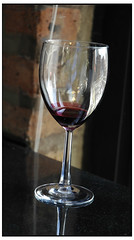Ha, the bastards have gotten me! But then I usually don't order entire bottles with my meal, I'll just sip a glass, or two if I'm feeling decadent. Bottles are for occasions, or for treating out-of-towners. My inner scrooge balks at the 400-800% mark-up. And the cork smelling is just out of hand, what is the point? Probably 75% of the time, the waiter will proffer the cork like he's holding a communion wafer. What, am I going to eat it?
Vino & Veritas - The Record - Etc.:
Restaurant tip #2: Staying in your price range. Once you know approximately how much you want to spend and whether you want red or white (if you want pink, you're probably not reading this column), call over the wine steward (or waiter, but more on that below) and point to some of the wines in your price range. Ask him for his recommendation, saying something like, “I'd like something around here.” As you say this, point to the prices you're willing to pay. Most wine stewards will take the hint and recommend a wine in that range. If he doesn't -- and this may happen -- don't be intimidated. Say, “Well, that's great, but I'd really like to stay around here.” He generally won't try it again. (If he says that he can't really recommend anything in that price range, which he rarely will, and if you're feeling sassy, which I often am, you might ask, “Then why is it on the list?” There's no good response to that.)
If you want to give him more information, tell him what you usually drink -- cabernet, merlot, Chianti -- and whether you're willing to experiment (a bad idea on first dates or job interviews, but a good idea if you have a willing partner).
And one last price tip I picked up from the Wall Street Journal's wine writers: Restaurant owners will often price the wine they buy cheapest at wholesale as the second cheapest wine on the menu. Why? Because people generally don't order the cheapest wine and thus often turn to the second cheapest. Price that one higher, and you get a bigger marginal profit. Presto -- restauranteur as microeconomist! ...The waiter will then open the bottle and “present the cork.” Do not sniff it. It just smells like cork. You could fondle it, if you're into that sort of thing, but otherwise just ignore it. (One exception: If you see that it's soaked through with wine, that's generally not good, as it means air probably got into the wine and could have ruined it. More on that below.) Next, the waiter will pour a little of the wine into your glass. Here's where the real challenge begins. You have three options: smell, taste or swirl/smell/taste. I usually just smell it to make sure it's not corked (corked wine smells musty, like old cardboard or yesterday's gym socks) or turned to vinegar (which smells like vinegar). If your nose is stuffed or you don't trust it, just take a big sip of the wine -- enough to really taste it. Unless you're trying to impress someone, don't swirl. It looks pretentious and is best left to wine geeks and people who read “Cigar Aficionado.” (Swirling does help release a wine's aromatics, and you might want to do it later in the meal; at the tasting stage, however, it just looks like you're trying too hard. Consider it the wine-drinking equivalent of pulling out her chair at the table.)
originally from Kottke
Technorati Tags: Food & Drink, Personal


Don't sniff the cork. Don't chew the cork. Don't even bother saving the cork for later (unless you've got something kinky in mind).
Just look at the cork!
Why? to see if there are streaks of wine that reach from one end to the other indicating that air might have gotten in and ruined your very expensive bottle of wine.